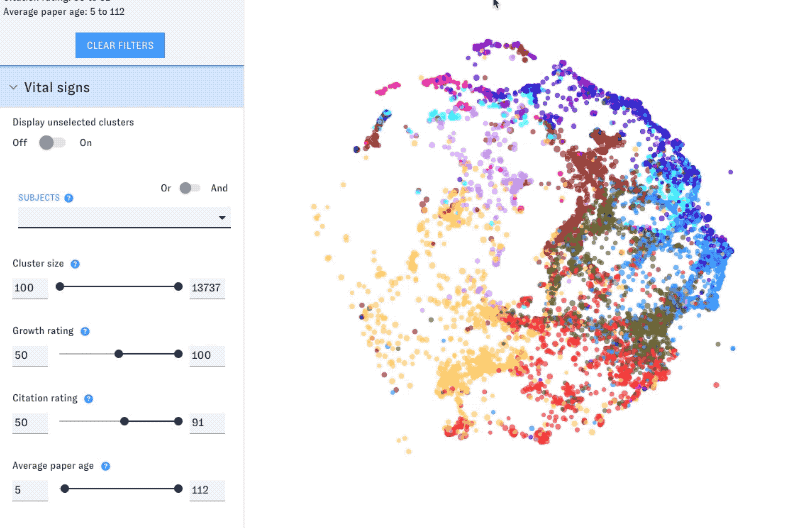This is the fourth post in our 🔥🔥Hot Topics🔥🔥 series. Follow along with each post as we use ETO's Map of Science to uncover and explore emerging topics in STEM. All of the research in this post was done using the Map of Science only, in less than an hour, by one non-expert analyst (your narrator). Earlier posts explored emerging topics in materials science, quantum research, and computing hardware.
China's world-class AI sector generates huge amounts of impactful research every year. It's hard to keep up with the latest - no matter whether you're a Mandarin-speaking AI expert, or just an amateur like the rest of us. Don't worry! With the Map of Science's filters, even amateurs have an ace up their sleeve.
Today, we'll use the Map to uncover areas worth watching in Chinese AI research. With the Map's deep coverage of both Chinese-language research and AI research (including AI preprints from sources like arXiv and Papers With Code), we're well equipped to explore. As in our earlier posts, we'll start by defining a set of filters that will capture especially "hot" research clusters in the Map. Different users might come up with different ways to do this - here's what we selected from the Map's filter pane:
- Cluster size: 100 articles or more, reflecting a pretty active area of research.
- Growth rating: 50th percentile or higher (relative to all clusters in the Map).
- Average article age: 5 years and under, reflecting lots of recent activity.
- Citation rating: 50th percentile or higher (relative to all clusters in the map), indicating that the cluster is cited often.

Now, we'll focus in on clusters with a lot of AI research and a lot of authors from Chinese institutions. Easy enough: the Map has built-in filters that use subject and author metadata from individual articles to find these clusters. (Read more about how we identify AI-relevant clusters and clusters with Chinese-affiliated authors).

Switch over to the Map's list view to see the 20 or so clusters that meet all of our criteria. Each represents a notable area of AI-related research with lots of authors from Chinese institutions in the mix.
Here's some of what they are working on:
| Cluster ID | What does this cluster seem to be about? (summary based on the cluster's keywords and top articles) | Share of articles with at least one author from a Chinese institution | Selected articles (selected from the "Articles and sources" pane in the cluster's detail view) | Other interesting features (based on information from the cluster's detail view) |
|---|---|---|---|---|
| 1989 | Graph neural networks (in general) | 50% (2646/5262) | "Deeper Insights into Graph Convolutional Networks for Semi-Supervised Learning" "How Powerful are Graph Neural Networks?" | Top three countries by article count: China (2646), U.S. (1474), Australia (300); the same countries ranked by citations (per-article yearly average): Australia (13.2), U.S. (10.17), China (3.93) |
| 19241 | Deep learning for hyperspectral image processing | 71% (1529/2139) | "Hyperspectral Image Classification With Deep Feature Fusion Network" "Advances in Hyperspectral Image Classification Based on Convolutional Neural Networks: A Review" | U.S.-affiliated authors published 67 articles in this cluster in 2021; 28 of them (42%) were collaborations with China-affiliated authors |
| 3568 | Machinery fault detection with AI | 77% (3910/5048) | "A deep convolutional neural network with new training methods for bearing fault diagnosis under noisy environment and different working load" "Applications of machine learning to machine fault diagnosis: A review and roadmap" | Almost a quarter of articles are solely in Chinese - an unusually high percentage |
| 13372 | Using machine learning in multiple-input/multiple-output wireless telecommunications | 51% (1212/2394) | "Machine Learning in the Air" "Deep Learning-based Channel Estimation for Beamspace mmWave Massive MIMO Systems" | 161 patents cite research in this cluster |
| 58382 | AI-based approaches to data fusion in remote sensing | 53% (249/468) | "Deep Encoder–Decoder Networks for Classification of Hyperspectral and LiDAR Data" "Identifying Corresponding Patches in SAR and Optical Images with a Pseudo-Siamese CNN" | Many articles in this cluster come from IEEE publications |
| 7227 | "Skeleton-based action recognition" | 56% (1206/2159) | "NTU RGB+D 120: A Large-Scale Benchmark for 3D Human Activity Understanding" "Skeleton-Based Action Recognition Using Spatio-Temporal LSTM Network with Trust Gates" | 211 patents cite articles in this cluster - sample title: "Method and system for recognizing emotions and actions" |
| 24615 | AI approaches to associating diseases with specific microRNA | 88% (1031/1165) | "A comprehensive survey on computational methods of non-coding RNA and disease association prediction" "Predicting miRNA-disease association based on inductive matrix completion" | Top author institution: China University of Mining and Technology (98 articles. 15.6 average yearly citations per article) |
| 63809 | Neuroimagery processing and diagnosis with AI | 66% (211/318) | "Unsupervised Manifold Learning Using High-Order Morphological Brain Networks Derived From T1-w MRI for Autism Diagnosis" "A toolbox for brain network construction and classification" | Leading author institutions are non-Chinese (Istanbul Technical Univesity, University of Dundee, UNC Chapel Hill), despite the heavy Chinese presence in the cluster as a whole |
| 13724 | Machine learning for scene classification in remote sensing imagery | 62% (1197/1939) | "PatternNet: A benchmark dataset for performance evaluation of remote sensing image retrieval" "Urban land-use mapping using a deep convolutional neural network with high spatial resolution multispectral remote sensing imagery" | Private companies associated with articles in this cluster include Lockheed Martin, Airbus, and several Chinese state-owned enterprises |
To access these results for yourself, click here to run the same search in the Map of Science. Our next and final Hot Topics post will cover emerging topics in global pharmacology research. Until then, happy exploring!

